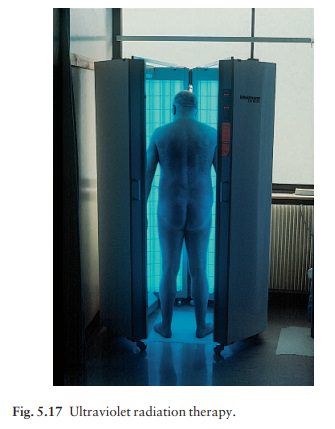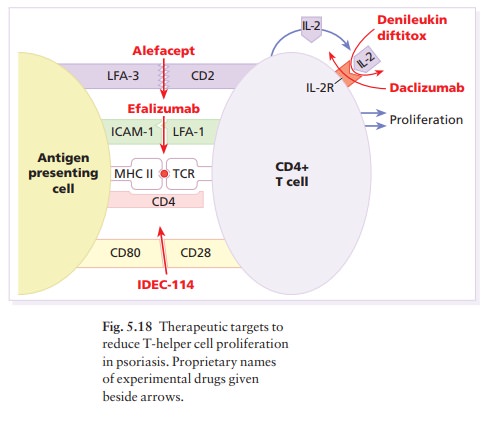Chapter: Clinical Dermatology: Psoriasis
Psoriasis: Systemic treatment
Systemic treatment
A
systemic approach should be considered if extensive psoriasis (more than 20% of
the body surface) fails to improve with prolonged courses of tar or dithranol.
As the potential side-effects are great, local measures should be given a good
trial first. The most commonly used systemic treatments are photochemotherapy
with psoralen and ultraviolet A (PUVA) treatment, retinoids, methotrexate,
hydroxyurea (hydroxycarbamide), sul-fasalazine, mycophenolate mofetil and
cyclosporin.
Photochemotherapy (PUVA)
In
this ingenious therapy, a drug is photo-activated in the skin by ultraviolet
radiation. An oral dose of 8-methoxypsoralen (8-MOP) or 5-methoxypsoralen
(5-MOP) is followed by exposure to long-wave ultra-violet radiation (UVA: 320
–400 nm). The psoralen reaches the skin and, in the presence of UVA, forms
photo-adducts with DNA pyrimidine bases and cross-links between complementary
DNA strands; this inhibits DNA synthesis and epidermal cell division.
The
8-MOP (crystalline formulation 0.6–0.8 mg/kg body weight or liquid formulation
0.3–0.4 mg/kg) or 5-MOP (1.2–1.6 mg/kg) is taken 1–2 h before exposure to a
bank of UVA tubes mounted in a cabinet similar to that seen in Fig. 5.17.
Psoralens may also be admin-istered in bath water for those unable to tolerate
the oral regimen. The initial exposure is calculated either by determining the
patient’s minimal phototoxic dose (the least dose of UVA that after ingestion
of 8-MOP produces a barely perceptible erythema 72 h after testing) or by
assessing skin colour and ability to tan. The usual starting dose is from 0.5
J/cm2 (skin type I: always burns and
never tans) to 2.0 J/cm2 (skin
type IV: never burns and always tans). Treatment is given two or three times a
week with increasing doses of UVA, depending on erythema production and the
therapeutic response. Protective goggles worn during radiation and UVA opaque
plastic glasses must be used after taking the tablets and for 24 h after each
treatment . All phototherapy equipment should be serviced and calibrated
regularly by trained personnel. An accurate record of each patient’s cumulative
dosage and number of treatments should be kept.

Clearance
takes 5–10 weeks. Thereafter it is often possible to keep the skin clear by
PUVA once a fort-night or every 3 weeks. However, as the side-effects of PUVA
relate to its cumulative dose , main-tenance therapy should not be used unless
alternative treatments prove to be unsatisfactory. As far as pos-sible, PUVA
therapy is avoided in younger patients.
Side
effects Painful erythema is the most commonside-effect but the risk
of this can be minimized by careful dosimetry. One-quarter of patients itch
during and immediately after radiation; fewer feel nauseated after taking 8-MOP.
5-MOP, not yet available in the USA, is worth trying if these effects become
intolerable. Long-term side-effects include premature ageing of the skin (with
mottled pigmentation, scattered lentigines,wrinkles and atrophy), cutaneous
malignancies (usually after a cumulative dose greater than 1000 J or after more
than 250 treatments) and, theoretically at least, cataract formation. The use
of UVA blocking glasses for 24 h after
each treatment should pro-tect against the latter. The long-term side-effects relate
to the total amount of UVA received over the years; this must be recorded and
kept as low as possible, without denying treatment when it is clearly needed.
Retinoids
Acitretin
(10–25 mg daily; Formulary 2) is an analogue of vitamin A, and is one of the
few drugs helpful in pustular psoriasis. It is also used to thin down thick
hyperkeratotic plaques. Minor side-effects are frequent and dose-related. They
include dry lips, mouth, vagina and eyes, peeling of the skin, pruritus,
thinning of the hair, and unpleasant paronychia. All settle on stopping or
reducing the dosage of the drug, but the use of emollients and artificial tears
is often recommended.
Acitretin
can be used on its own for long periods, but regular blood tests are needed to
exclude abnormal liver function and the elevation of serum lipids (mainly
triglycerides but also cholesterol). Yearly X-rays should detect bone spurs and
ossification of ligaments, espe-cially the paraspinal ones (disseminated
interstitial skeletal hyperostosis (DISH) syndrome). Children, and those with
persistently abnormal liver function tests or hyperlipidaemia, should not be
treated.
The
most important side-effect is teratogenicity and acitretin should not normally
be prescribed to women of childbearing age. If, for unavoidable clinical
reasons, it is still the drug of choice, effective oral contracept-ive measures
must be taken and, in view of the long half-life of its metabolite, these
should continue for 2 years after treatment has ceased. Blood donation should be
avoided for a similar period.
Retinoids
and PUVA act synergistically and are often used together in the so-called
Re-PUVA regimen. This clears plaque psoriasis quicker than PUVA alone, and
needs a smaller cumulative dose of UVA. The standard precautions for both PUVA
and retinoid treatment should, of course, still be observed.
Methotrexate
This
folic acid antagonist (Formulary 2) inhibits DNA synthesis during the S phase
of mitosis. After an initial trial dose of 2.5 mg, in an adult of average
weight, the drug is given orally once a week and the dose increased gradually
to a maintenance one of 7.5–15 mg/week. This often controls even aggressive
psoriasis. The drug is eliminated largely by the kidneys and so the dose must
be reduced if renal function is poor. Aspirin and sulphonamides displace the
drug from binding with plasma albumin, and frusemide (furosemide) decreases its
renal clearance: note must therefore be taken of concurrent drug therapy and
the dose reduced accord-ingly. Minor and temporary side-effects, such as nausea
and malaise, are common in the 48 h after administra-tion. The most serious
drawback to this treatment is hepatic fibrosis, the risk of which is greatly
increased in those who drink an excessive amount of alcohol. Unfortunately,
routine liver function tests and scans cannot predict this reliably, and a
liver biopsy to exclude active liver disease is advised for those with risk
factors. Exceptions are made for patients over 70 years old and when only
short-term treatment with methotrexate is anticipated. Liver biopsy before
treatment, or early in the course of therapy, should be repeated after every
cumulative dose of 1.5–2 g, especially in less than perfectly healthy drinking
adults. Blood checks to exclude marrow suppression, and to monitor renal and
liver function, should also be performedaweekly at the start of treatment, with
the interval being slowly increased to monthly or every other month depending
on when stable maintenance therapy is established.
The
drug is teratogenic and should not be given to females in their reproductive
years. Oligospermia has been noted in men and fertility may be lowered;
however, a child fathered by a man on methotrexate can be expected to be
normal. Folic acid, 5 mg daily, taken on days when the patient does not have
methotrexate, can lessen nausea and reduce marrow suppression. Methotrexate
should not be taken at the same time as systemic steroids or cyclosporin.
Cyclosporin
Cyclosporin
inhibits cell-mediated immune reactions. It blocks resting lymphocytes in the G0
or early G1 phase of the cell cycle and
inhibits lymphokine release, especially that of IL-2.
Cyclosporin
is effective in severe psoriasis, but pati-ents needing it should be under the
care of specialists. The initial daily dose is 3– 4 mg/kg/day and not more
With improvement the dose can often be reduced but the
side-effects of long-term treatment include hypertension, kidney damage and
persistent viral warts with a risk of skin cancer. Blood pressure and renal
function should be assessed care-fully before starting treatment. The serum
creatinine should be measured two or three times before starting therapy to be
sure of the baseline and then every other week for the first 3 months of
therapy. Thereafter, if the results are stable, the frequency of testing will
depend on the dosage (monthly for >
2.5 mg/kg/day or every other month for <
2.5 mg/kg/day). The dosage should be reduced if the serum creatinine
concentration rises to 30% above the baseline level on two occasions within 2
weeks. If these changes do not reverse them-selves when the dosage has been
reduced for 1 month, then the drug should be stopped.
Hypertension
is a common side-effect of cyclosporin: nearly 50% of patients develop a
systolic blood pres-sure over 160 mmHg and/or a diastolic blood pressure over
95 mmHg. Usually these rises are mild or moder-ate, and respond to concomitant
treatment with a calcium channel blocker, such as nifedipine. If this cannot be
tolerated, an angiotensin-converting enzyme inhibitor should be used under
specialist supervision. Diuretics, which may themselves worsen renal func-tion,
and β blockers,
which may themselves worsen psoriasis, should probably be avoided. Cyclosporin
interacts with a number of drugs and
these should be avoided.
It
is also advisable to watch levels of cholesterol, triglycerides, potassium and
magnesium, and advise patients that they will become hirsute and that they may
develop gingival hyperplasia. Treatment with cyclosporin should not continue
for longer than 1 year without careful assessment and close monitoring.
Other systemic drugs
Antimetabolites
such as mycophenolate mofetil, 6-tioguanine, azathioprine and hydroxyurea help
psori-asis, but less than methotrexate; they tend to damage the marrow rather
than the liver. Regular blood moni-toring is again essential. Sulfasalazine
occasionally helps psoriasis.

Related Topics